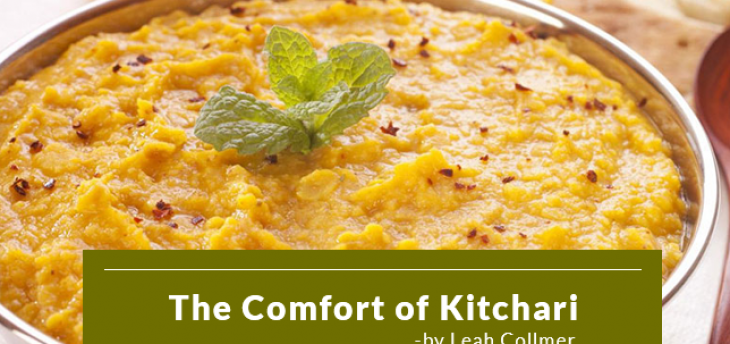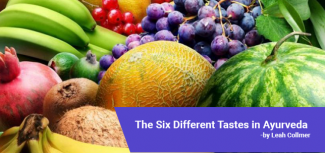
Everyone loves comfort food. It is that feeling we all crave: the feeling of being deliciously loved while eating something scrumptious. For many Westerners and Indians alike, that might be in the form of something ghastly fattening or terribly unhealthy. Regret, often accompanied by heartburn, gas, indigestion, depression or weight gain soon settles in afterwards, leaving us moaning and groaning about our cravings.
Then along comes kitchari, Ayurveda’s chicken soup for the body and soul. It is golden rich in color and made of the stuff that nourishes you to the bone. Kitchari is an ancient Indian dish with documented mention dating back to the 14th century. It is made from split yellow mung dal (a type of lentil), and white basmati rice, along with spices and select vegetables. According to Ayurveda, kitchari has many redeeming benefits and is more than just your everyday comfort food. While being nourishing, healing and tasty, kitchari is an amazing salve for a sick or wounded body. It decreases inflammation, promotes healing in the digestive tract, reduces gas, acts as a natural detox, facilitates weight loss and soothes the mind. It is great for anyone recovering from an illness. Also read the six different tastes in Ayurveda.
It balances all three doshas: (constitutions of the body), Vata, Pitta and Kapha. Just as it has adaptability to all the doshas, so is kitchari’s form. Depending on how one likes it, kitchari’s consistency can be creamy and dreamy like a pudding, or deliciously dense like an Italian risotto. It is easy to cook and can be eaten for any meal. It can be the main staple in a mono-diet or cleanse. It is safe to eat kitchari for up to seven days, helping the body detox and recalibrate. Kitchari strengthens the digestive fire (agni), and therefore is toning for the liver as well. Below is a breakdown of the properties of the main ingredients, followed by recipes.
Yellow Mung Dal – is sweet, astringent, cooling, dry and easily digestible, reducing all the doshas. It is low in fat, and high in B vitamins, calcium and potassium. It is a reliable source of protein and fiber and has zero cholesterol.
Single Grain White Basmati Rice – is very balancing for all three doshas and has a Sattvic (pure), quality making it very calming for the mind. It is also light, sweet, moist and cooling. Why white rice? It is easier to digest. During a purifying time, easy digestion is key. For all the brown rice lovers like myself, kitchari is so hearty that you won’t miss the brown rice. The ease of digesting it will bring an unfound joy to your experience. The smell of fresh grain basmati rice right out of the bag is heaven.
Ghee – is clarified butter that is lactose and casein free. It is nourishing to the tissues, soothes the digestive tract and builds agni (digestive fire). It is unctuous, cool, sweet and light. It transports nourishment deep into the body and has the ability to cross the blood-brain barrier.
The recipes written below are shared with very fond memories. I cannot take credit for them, as they were a gift to me in my very first Panchakarma, by my devoted therapist and practitioner, Ashlee. Each day Ashlee would come to my room with a fresh, home-made bowl of kitchari, just warm out of her kitchen, safely bundled in her car and delivered to me. The love and devotion I felt from each bowl of kitchari made by her hands was like a warm hug in a rocking chair. Each day the taste was divine, as if I were tasting something anew for the first time. During these 10 days of my first Panchakarma, the kitchari never got boring, dull or repetitive and I savored each spoonful. Sometimes famished after a Panchakarma treatment I would devourer every last morsel, licking the bowel clean. Other times, a few hearty spoonfuls were enough to satisfy my appetite, sticking to my bones as it went down, warming me from the inside out.
These four recipes below are very tailored, corresponding to each dosha and correlating to each season to help ensure optimal health. Although they are classically balanced, feel free to experiment according to your own palate. You can always go back to the original recipe if you aren’t getting the results you want. Remember not to add salt until the end, as it hardens the lentils, preventing them from cooking thoroughly and becoming soft.
Kitchari #1 :VPK – especially good for Vata constitution or imbalance and during cold, dry, autumn and winter weather (Vata season)
1 cup basmati rice
½ cup split mung dal
3 Tbls ghee
1 tsp mustard seeds (whole)
2 tsp cumin seeds (whole)
2 pinches hing (asafoetida)
2 tsp whole coriander seeds
½ tsp cardamom
½ tsp turmeric
1 carrot washed and diced
½ onion diced
1 tsp salt
4 cups water
Wash the rice and mung dal well. If you have time, let the mung dal soak for a few hours before cooking to make them even easier to digest.
In a saucepan over medium heat, melt the ghee and add the chopped onion and spices (except the turmeric). Cook until the mustard seeds begin to pop and the spices have become aromatic. Add the chopped carrots and sauté for 1 minute.
Add the rice, mung, turmeric and salt and stir until well blended with the spices.
Add the water and bring to a boil. Boil for 5 minutes, uncovered, stirring occasionally.
Turn down the heat to low, cover, leaving the lid slightly ajar. Cook until tender, about 20-25 minutes.
Kitchari #2: VPK– Especially good for Pitta constitution and/or imbalance and during the hot, dry summer season (Pitta season). The cilantro and coconut both have a cooling nature which aids to reducing excess Pitta in the body and mind. Mung dal also has antacid properties which aids Pitta type digestion and hyperacidity/heartburn.
1 cup mung dal (split or sprouted whole mung dal)
1 cup basmati rice
1 ½ inch fresh ginger, peeled and chopped finely
2 Tbsp unsweetened, shredded coconut flakes
1 handful chopped cilantro
½ cup water
3 Tbsp ghee
½ tsp turmeric
¼ tsp salt
6 cups water
Wash the mung dal and rice. If you have time, soak the mung for a few hours before cooking to aid in digestion. Drain after they have soaked for a few hours.
Dice the ginger, coconut, cilantro, adding it to the ½ cup along with turmeric and salt, and mix until smooth. (Or put all ingredients in a processer or blender.)
Heat the ghee on medium in a large saucepan and add the blended mixture to the saucepan, stir well.
Add the rice, mung dal, and the 6 cups of water. Bring to a boil for 5 minutes uncovered. Then cover, leaving the lid slightly ajar, and turn down the heat to simmer. Cook for 25 to 30 minutes, until the dal and the rice are tender.
Kitchari #3: VPK– This recipe is tridoshic but is especially suited for Kapha Dosha constitution or imbalance individuals as well as good for most people during early spring when the weather is moist, heavy, and beginning to warm up after the long winter months. The more pungent spices in this recipe help to burn up excess Kapha (water and earth elements) while stoking the digestive fire.
1 cup split or sprouted whole mung dal
1 cup basmati rice
3 Tbsp ghee
4 bay leaves
4 small pieces cinnamon bark
6 whole cloves
4 whole cardamom pods
10 black peppercorns
2-3 pinches of cayenne pepper
6 cups water
¼ tsp salt
Rinse the mung dal and rice. If you have time, soak the mung dal.
Heat a saucepan on medium heat and add the ghee. When the ghee has melted, add the bay leaves, cinnamon, cloves, and cardamom and stir until the spices are mixed and fragrant.
Mix in the rice, dal, salt, and water. Cook at a low boil, uncovered, for 5 minutes. Cover and cook on low heat until the dal and rice are soft, about 25-30 minutes.
Kitchari #4: VPK– This kitchari is beneficial for balancing all three doshas during the spring and has a balance of pungent, cooling, and nourishing spices.
1 cup split mung, soaked
1 cup basmati rice
1 inch piece of ginger peeled and chopped finely
2 tbsp shredded coconut
1 handful cilantro leaves chopped
½ cup water
3 Tbsp ghee
1 ½ inch piece of cinnamon
5 whole cardamom pods
5 whole cloves
10 black peppercorns
3 bay leaves
½ tsp turmeric
½ tsp salt
6 cups of water
Wash the mung and rice.
Dice the ginger, coconut and cilantro adding to a ½ cup water, with salt, and turmeric, blending until smooth. (Food processor or blender optional.)
Heat a large saucepan on medium heat and add the ghee, cinnamon, cloves, cardamom, peppercorns, and bay leaves. Stir for a moment until fragrant.
Add the blended items to the spices. Stir until lightly browned.
Stir in the mung dal and rice and mix well.
Add the 6 cups of water, cover and bring to a boil. Let boil for 5 minutes, then turn down the heat to low and cook, lightly covered, until the dal and rice are soft, about 25 – 30 minutes.
Also Read : Ayurveda Food for Kapha Prakruti
Written by: LEAH COLLMER
 Leah Collmer is a certified Wellness Educator, Yoga Teacher, Laughter Yoga Teacher & Trainer and Aroma Therapist. She loves all things Ayurveda, and has a passion for working with children, cooking, ethnic food, and foreign culture. Leah has been writing for over 25 years and has had the great fortune of writing for heads of state, ambassadors, award-winning photo journalists, and non-profits committed to changing the world. Since 2015, she has been in India exploring the depths of the body/mind connection through Ayurveda, Yoga and Meditation. Leah offers practical and productive Life and Wellness Coaching to anyone who is on a path. Love, balance and embracing life is the key for her. Leah’s favorite holiday is Holi Festival and she is deeply grateful to all her teachers who have helped her on her path.
Leah Collmer is a certified Wellness Educator, Yoga Teacher, Laughter Yoga Teacher & Trainer and Aroma Therapist. She loves all things Ayurveda, and has a passion for working with children, cooking, ethnic food, and foreign culture. Leah has been writing for over 25 years and has had the great fortune of writing for heads of state, ambassadors, award-winning photo journalists, and non-profits committed to changing the world. Since 2015, she has been in India exploring the depths of the body/mind connection through Ayurveda, Yoga and Meditation. Leah offers practical and productive Life and Wellness Coaching to anyone who is on a path. Love, balance and embracing life is the key for her. Leah’s favorite holiday is Holi Festival and she is deeply grateful to all her teachers who have helped her on her path.
If you are looking for Ayurveda nutrition courses in Kerala, contact Greens Ayurveda right away. Call us at +91 496 2504334 now!
 Tips To Beat Summer Heat – Ayurvedic Way By Leah Collmer
Tips To Beat Summer Heat – Ayurvedic Way By Leah Collmer
It’s summer ti...
 The Six Different Tastes in Ayurveda by Leah Collmer
The Six Different Tastes in Ayurveda by Leah Collmer
There are six tastes in ayurveda (rasas...
 The Tongue Scraper – Ayurveda’s Secret Tool by Leah Collmer
The Tongue Scraper – Ayurveda’s Secret Tool by Leah Collmer
The idea of tongue scraping might sound primitiv...

Certified Wellness Educator, Yoga Teacher, Laughter Yoga Teacher & Trainer and Aroma Therapist.